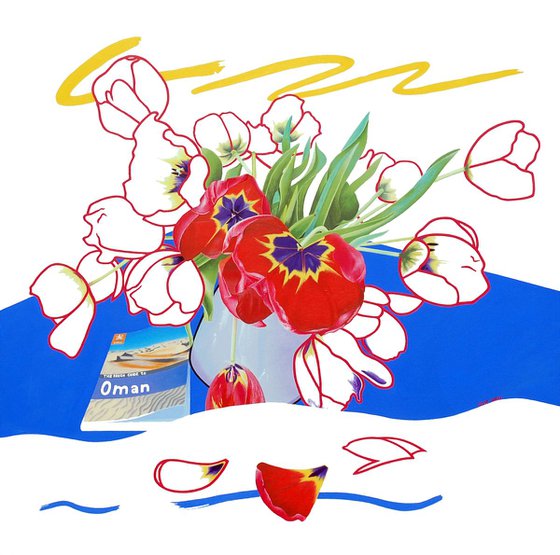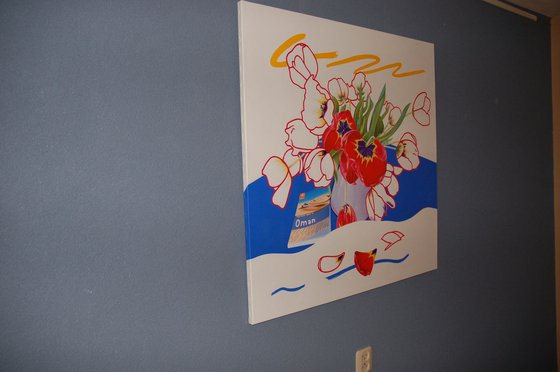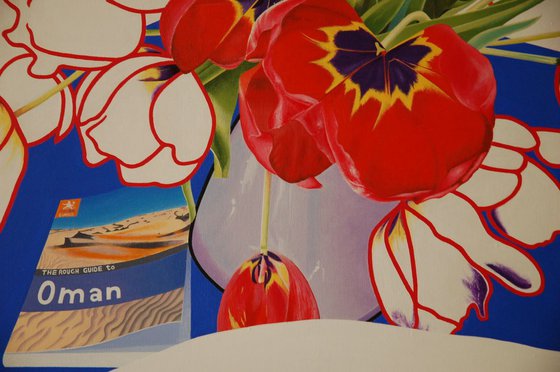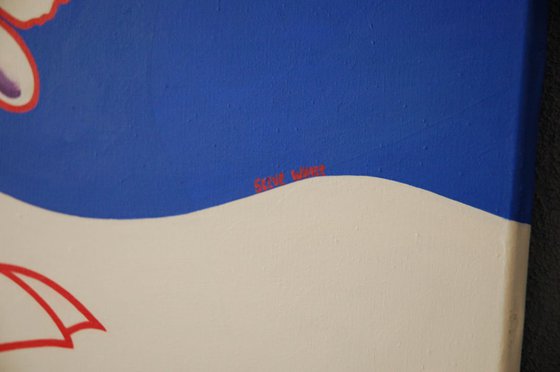- By medium
- By subject
- By budget
- Sales
- Gift cards
- Discover all art
- Artists
- Editors’ picks
- Ideas
Original artwork description:
In another life, one October in the early 80s, I found myself short of funds departing a kibbutz in the wilds of Hokkaido, Japan's northernmost island, heading back to Shepherds Bush, London W12.
It is against my religion to fly anywhere but my place crewing on a yacht from Yokohama to San Francisco fell through, the Trans-Siberian sounds boring, North Korea is an insurmountable bureaucratic hurdle, so I was forced to fly to Hong Kong where I took a train to the border, and another train to Canton. In Canton I caught the Slow Express (uh?) to Xian where I waited 15 hours, letting three trains go through because they were crowded and physically impossible to get inside. The fourth train was also crowded and physically impossible to get inside, but I had had enough of Xian station and as the train pulled out of the station I found myself hanging on to someone hanging on. Not long after the train cleared the platform we all managed to fight our way inside, where I slept standing up for the next seven hours until floor space became available.
It took a couple of days to reach Urumqi where I caught a bus across the desert to Kashgar, a trip which involved spending 2 nights in upmarket coal bunkers. In Kashgar I was informed that the road over the Himalaya into Pakistan was closed due to a landslide, and that it would not now reopen until March, because of winter. In the early 80s the route out through Tibet to Nepal was off limits and the only sensible way out of Kashgar was back to Hong Kong, from whence I had come.
However, in Kashgar I met a group of friendly Pakistanis who were also stuck in Kashgar and they said when the road was cleared of the landslide their bus would leave for Pakistan and I could travel with them if I wanted. Six weeks later with my Chinese and Pakistan visas both expired, we made it over the Khunjerbab Pass and I headed to Islamabad to get a visa for Iran. But the Iran/Iraq war was raging at this time and the bearded, polo-shirted guys in the Iranian Embassy were not minded to give visas to foreigners. Afghanistan, occupied by the Russians, was also off limits so I took a bus to Lahore and was briefly detained by police on suspicion of smuggling drugs. In Lahore I was informed the land border with India was closed, and I was forced to fly to Delhi where I caught a train to Bombay and a ferry to Goa, where I hung around for a couple of months thinking about things and eating banana pancakes. In Goa I met a Swede who said he had heard rumours from an Israeli in Kathmandu that it was possible for foreigners to obtain visas to travel the Pipeline Road across Saudi Arabia from Dhahran to Jordan, and that he was going to Bombay to try get a dhow to the Gulf. I had my doubts about dhows but this Pipeline Visa sounded intriguing and I resolved to get the shortest possible flight I could out of Delhi or Bombay in the direction of the Pipeline. I checked an atlas and found the closest country west of India that was not Pakistan or Iran or Afghanistan, was Oman.
I now live in the Netherlands, which is nothing like Oman, but where tulips are very nice at this time of year. Your image of a tulip as a simple blob of colour is quite wrong - there are thousand of hybrids with different shapes, colours and sizes, some bigger than your hand.
As a genre 'Still Life' painting - from the Dutch ‘stilleven’ - probably started in the Netherlands in the 16th century. In those days a still life inevitably depicted dead game and other inanimate objects such as jars, pots, pipes etc. This still life was not artfully set up - the tulips were there, the book was there (my wife collect travel guides), I took a photo, I painted a picture.
Historical note: Tulips were first cultivated in Persia (Iran) in the 10th century. They were introduced to north-west Europe around the 1500s.
I never got to Iran; I never got to Oman; but I did get to Amman. I couldn't get a visa for Oman so I took a flight to Jordan, where I landed in a blizzard, caught a boat from Aqaba to the Sinai, did a lap of Egypt, then Israel, caught another boat from Haifa to Rhodes, a speed boat to Marmaris in Turkey, a bus from Istanbul to Frankfurt (on which every passenger was given two brand new Turkish shirts to import to Germany), hitched to France, caught a train to Waterloo, and a Central Line Tube to Shepherds Bush, London W12.
This is the backstory behind this painting.
Materials used:
Acrylics
Tags:
#flowers #abstraction #still life with flowers #tulips #still life with booksThe Rough Guide to Oman (2018) Acrylic painting
by Steve White
2 Artist Reviews
£733.72
- Acrylic painting on Canvas
- One of a kind artwork
- Size: 90 x 90 x 2cm (unframed) / 90 x 85cm (actual image size)
- Ready to hang
- Signed on the front
- Style: Graphic, illustrative and typographic
- Subject: Flowers and plants
Loading
Original artwork description
In another life, one October in the early 80s, I found myself short of funds departing a kibbutz in the wilds of Hokkaido, Japan's northernmost island, heading back to Shepherds Bush, London W12.
It is against my religion to fly anywhere but my place crewing on a yacht from Yokohama to San Francisco fell through, the Trans-Siberian sounds boring, North Korea is an insurmountable bureaucratic hurdle, so I was forced to fly to Hong Kong where I took a train to the border, and another train to Canton. In Canton I caught the Slow Express (uh?) to Xian where I waited 15 hours, letting three trains go through because they were crowded and physically impossible to get inside. The fourth train was also crowded and physically impossible to get inside, but I had had enough of Xian station and as the train pulled out of the station I found myself hanging on to someone hanging on. Not long after the train cleared the platform we all managed to fight our way inside, where I slept standing up for the next seven hours until floor space became available.
It took a couple of days to reach Urumqi where I caught a bus across the desert to Kashgar, a trip which involved spending 2 nights in upmarket coal bunkers. In Kashgar I was informed that the road over the Himalaya into Pakistan was closed due to a landslide, and that it would not now reopen until March, because of winter. In the early 80s the route out through Tibet to Nepal was off limits and the only sensible way out of Kashgar was back to Hong Kong, from whence I had come.
However, in Kashgar I met a group of friendly Pakistanis who were also stuck in Kashgar and they said when the road was cleared of the landslide their bus would leave for Pakistan and I could travel with them if I wanted. Six weeks later with my Chinese and Pakistan visas both expired, we made it over the Khunjerbab Pass and I headed to Islamabad to get a visa for Iran. But the Iran/Iraq war was raging at this time and the bearded, polo-shirted guys in the Iranian Embassy were not minded to give visas to foreigners. Afghanistan, occupied by the Russians, was also off limits so I took a bus to Lahore and was briefly detained by police on suspicion of smuggling drugs. In Lahore I was informed the land border with India was closed, and I was forced to fly to Delhi where I caught a train to Bombay and a ferry to Goa, where I hung around for a couple of months thinking about things and eating banana pancakes. In Goa I met a Swede who said he had heard rumours from an Israeli in Kathmandu that it was possible for foreigners to obtain visas to travel the Pipeline Road across Saudi Arabia from Dhahran to Jordan, and that he was going to Bombay to try get a dhow to the Gulf. I had my doubts about dhows but this Pipeline Visa sounded intriguing and I resolved to get the shortest possible flight I could out of Delhi or Bombay in the direction of the Pipeline. I checked an atlas and found the closest country west of India that was not Pakistan or Iran or Afghanistan, was Oman.
I now live in the Netherlands, which is nothing like Oman, but where tulips are very nice at this time of year. Your image of a tulip as a simple blob of colour is quite wrong - there are thousand of hybrids with different shapes, colours and sizes, some bigger than your hand.
As a genre 'Still Life' painting - from the Dutch ‘stilleven’ - probably started in the Netherlands in the 16th century. In those days a still life inevitably depicted dead game and other inanimate objects such as jars, pots, pipes etc. This still life was not artfully set up - the tulips were there, the book was there (my wife collect travel guides), I took a photo, I painted a picture.
Historical note: Tulips were first cultivated in Persia (Iran) in the 10th century. They were introduced to north-west Europe around the 1500s.
I never got to Iran; I never got to Oman; but I did get to Amman. I couldn't get a visa for Oman so I took a flight to Jordan, where I landed in a blizzard, caught a boat from Aqaba to the Sinai, did a lap of Egypt, then Israel, caught another boat from Haifa to Rhodes, a speed boat to Marmaris in Turkey, a bus from Istanbul to Frankfurt (on which every passenger was given two brand new Turkish shirts to import to Germany), hitched to France, caught a train to Waterloo, and a Central Line Tube to Shepherds Bush, London W12.
This is the backstory behind this painting.
Materials used:
Acrylics
Tags:
#flowers #abstraction #still life with flowers #tulips #still life with books14 day money back guaranteeLearn more





